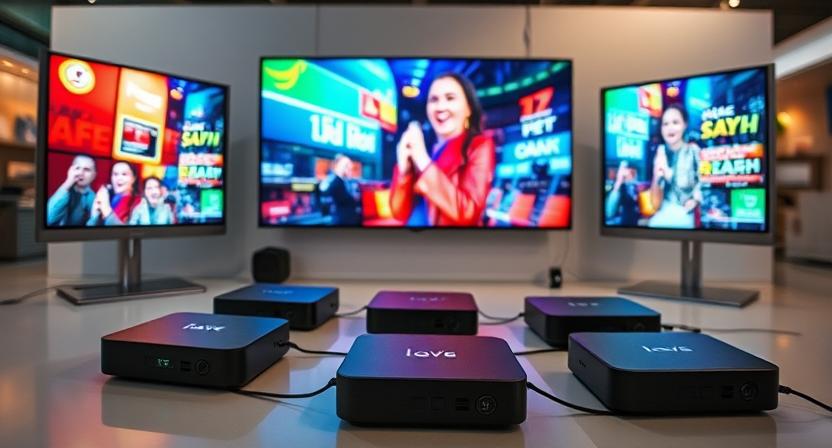The Role of Android Boxes in Transforming Digital Signage Advertising
Digital advertising has entered a new era where interactive content, real-time data, and intelligent display systems drive customer engagement. At the center of this transformation lies the Android Box for Advertising. These compact yet powerful devices are redefining how brands communicate through smart screens, retail displays, and digital billboards worldwide.
1. From Traditional Displays to Smart Advertising
Before the rise of digital signage, static posters dominated the advertising landscape. They were costly, time-consuming to replace, and limited in audience impact. The arrival of digital signage android box solutions has completely disrupted this model. Businesses can now deliver dynamic video content, animations, and interactive campaigns across multiple screens, all controlled remotely.
Unlike traditional systems, the Android Box for Advertising integrates both hardware performance and smart software management to enable smooth playback, network scheduling, and analytics—all essential for modern marketing strategies.
2. Why Android Box for Advertising Is Revolutionizing Digital Signage
The open-source nature of Android gives manufacturers and brands the flexibility to customize their content experience. This is why the android advertising player is quickly becoming the go-to choice for advertisers seeking both scalability and cost efficiency.
Supports 4K and 8K video streaming for ultra-clear advertising visuals.
Runs on stable Android OS versions optimized for continuous operation.
Provides cloud-based content control through easy-to-use interfaces.
Allows integration with analytics and interactive modules.
Whether it’s a retail store or airport terminal, Android Box for Advertising ensures consistent performance and global connectivity.
3. Advanced Hardware and Software Integration
Today’s smart advertising display devices are more than just video players—they’re intelligent systems. Powered by high-end processors such as Rockchip RK3566 and Amlogic S905X4, Android boxes deliver exceptional graphics rendering, ensuring seamless playback even during high-load campaigns.
Combined with Android 11/12 OS, these systems offer compatibility with various CMS platforms and can integrate AI-driven content recommendations for improved relevance and impact. This balance between power and usability has positioned Android Box for Advertising as the preferred solution in smart retail and commercial environments.
4. Cloud Management and Real-Time Control
Centralized cloud management systems allow marketers to update hundreds of screens simultaneously, no matter where they are located. Through these digital signage android box platforms, businesses can schedule content updates, monitor device status, and even receive alerts if a display malfunctions.
This automation not only saves time but also ensures consistent branding and timely promotions across all locations. For example, restaurant chains can update menu boards nationwide within minutes, while shopping malls can switch seasonal campaigns instantly.
5. The Role of AI and Data Analytics
Artificial intelligence (AI) integration is making Android Box for Advertising smarter every year. With camera sensors and machine learning algorithms, these systems can analyze audience demographics, dwell time, and engagement rates.
By processing this data, advertisers can tailor content to specific audiences—displaying relevant ads to different age groups or times of day. This data-driven approach enhances ad efficiency and provides measurable ROI.
6. Interactive Advertising Through Touch and Sensors
Interactivity is a major trend in digital signage. Interactive digital signage solutions use touchscreens, gesture controls, or motion sensors to engage customers directly. Android-based devices provide the necessary framework to handle these technologies efficiently.
Retailers use these systems to create immersive experiences—allowing users to browse product catalogs, view 3D models, or customize products directly on-screen. This interaction improves engagement and strengthens the emotional connection between brand and audience.
7. Scalability and Flexibility for Global Networks
For enterprises operating globally, scalability is crucial. The Android Box for Advertising supports multi-location deployment with minimal setup. Content can be localized per region or language while maintaining central control.
This flexibility is why multinational companies and franchise chains increasingly rely on Android boxes to manage their in-store advertising networks efficiently and securely.
8. Cost Efficiency and Sustainability
Compared to legacy display PCs, Android-based systems offer significant savings in both hardware and energy consumption. Their compact form factors, low power requirements, and long operational lifespan reduce maintenance and operational costs.
Moreover, the lightweight Android OS ensures efficient performance without the need for expensive licenses or constant manual updates. These sustainable benefits make Android Box for Advertising an environmentally responsible choice for businesses seeking greener technology solutions.
9. Enhanced Security and Maintenance
Security remains a top priority in large advertising networks. Advanced android media box devices now include AES encryption, firewall settings, and remote firmware updates to protect both data and operations.
Administrators can control access permissions and monitor content uploads, ensuring system stability and brand safety. OTA updates guarantee that each device remains up-to-date with the latest software patches, minimizing downtime.
10. Real-World Use Cases and Success Stories
The impact of Android Box for Advertising is visible across multiple industries:
Retail Chains: Brands use dynamic product displays and video walls to increase foot traffic.
Restaurants: Digital menu boards help manage real-time promotions and reduce print waste.
Corporate Buildings: Internal communication screens share announcements and KPIs.
Transportation Hubs: Smart displays provide travelers with updates and targeted ads.
These examples highlight how Android technology is revolutionizing both customer experience and operational efficiency.
Conclusion: The Future of Smart Advertising
As digital communication evolves, Android Box for Advertising stands as a pivotal innovation bridging hardware, software, and creativity. With capabilities in AI, automation, and remote management, it enables businesses to deliver intelligent, engaging, and cost-effective advertising experiences.
Looking to modernize your advertising network? Contact our expert Android display solutions team today to explore tailored options that boost engagement, efficiency, and ROI for your brand.
READ MORE
How Android Boxes Elevate Interactive Advertising Experiences
Why Android Boxes Are Essential for Next-Gen Advertising Platforms
How Android Boxes Drive Innovation in Smart Advertising Systems
The Impact of Android Boxes on Interactive Advertising Experiences
Enhancing Retail Engagement with Android Box for Advertising
How Android Boxes Enable Smarter, Data-Driven Advertising Displays
Quick Links





.png)
.png)






.png)

.png)














